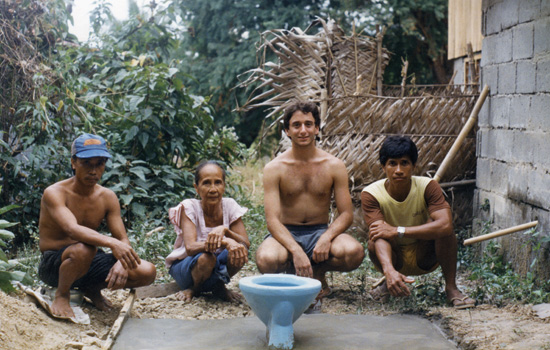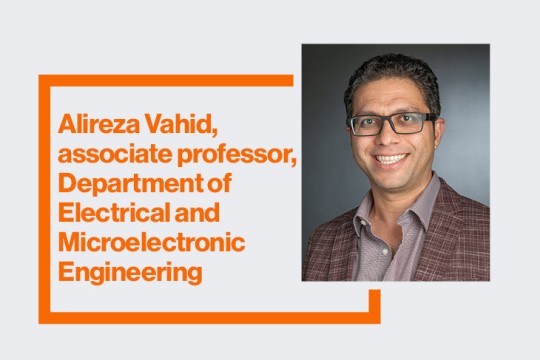Corps Values
On the 50th anniversary of the Peace Corps, RIT graduates talk about their service
Daniel Kramer ’86, center, worked with the Philippines Department of Health to install 75 sealed toilets for people who had been using open-trench latrines.
During her junior year at RIT, Amona White ’03 (mechanical engineering technology) spent spring break in Jamaica.
This was no vacation on the beach. She and other members of RIT’s InterVarsity Christian Fellowship presented puppet shows at an orphanage and did construction work at the Caribbean School of the Deaf. The following year, members headed to Guyana, South America.
The trips “made me realize this kind of humanitarian outreach was something I wanted to devote at least a few years to,” White says. “I had the rest of my life to be an engineer.”
Following graduation, she joined the Peace Corps. White taught school in a small village in Namibia, southern Africa, from October 2003 to December 2005. She’s especially proud of helping to found a girls club, aimed at raising self-awareness in young women.
White now works as a quality engineer for an international company in Buffalo, but she hasn’t forgotten the people she met. She hopes to organize a club to connect girls in the U.S. with their counterparts in Namibia.
“That’s my dream.”
Since the Peace Corps began in 1961, 78 RIT graduates have pursued the ideal of promoting friendship between Americans and other people of the world.
As the Peace Corps celebrates its 50th anniversary this year, President John F. Kennedy’s call to service continues to resonate with many young Americans.
In a survey of 56,900 college students conducted last year by the research firm Universum USA, the Peace Corps ranked No. 8 on a list of “dream employers,” following Google Inc., Walt Disney Co., the FBI, Apple Inc., Ernst & Young, U.S. State Department and NASA.
Currently, 8,655 volunteers are serving worldwide, more than at any time since 1970. Peace Corps applications have increased over the past decade, from 8,912 in 2001 to 13,430 in 2010. In fact, there are more Americans applying to serve than there are positions available: About one in three applicants will serve with a Peace Corps program overseas.
Different culture
Peace Corps volunteers live and work alongside citizens of the host nations on a variety of projects. For example:
- Daniel Kramer ’86 (printing management), served in the Philippines, 1988-1990, on projects including beekeeping, raising rabbits and planting more than 500 mango trees. He organized a dental/eyeglass clinic and helped distribute eyeglasses in connection with Lyons Clubs. And, working with the Philippines Department of Health, he helped secure a grant to obtain and install 75 sealed toilets for people who had been using open-trench latrines.
- Laura M. Stevens Smith ’98 (biotechnology) served as a community health worker in Niger, western Africa, 1999-2001.
- Judith Willis-Chiapellone ’91 (dietetics and nutrition care) worked in a hospital and taught nutrition and basic health to school children in the Philippines, 1994-1996.
- Peter Williams ’99 (biology) served in The Gambia, western Africa, 2007-2009. He worked in a family planning center and educated young people about HIV/AIDS, condom use, malaria and breast-feeding. He also worked in the lab of a regional hospital and helped plant a vegetable garden of about 320 fruiting and flowering trees for the facility.
- Ken Nielson ’69, ’83 (mechanical-industrial science, MBA) served with his wife, Marcia, in Poland, 1992-1994, shortly after the breakup of the Soviet Union. He taught college business courses.
There’s no doubt that Peace Corps services change lives—on both sides of the equation.
Williams had done a service trip while at RIT and worked in a hospital in India for a time before entering the Peace Corps.
In The Gambia, he shared the home of a family of five. There was no electricity, no running water.
“It was hard,” he says. “Everything was different than here. You’re living in a completely different culture, where you’re the outsider.”
The reward is “touching people’s lives. And they touched me as much as I touched them.”
Upon returning home, Williams went back to work in a research lab at the University of Pittsburgh. But he remains committed to international service. On his own, he spent a month working in a hospital in Haiti following the devastating earthquake in 2010. He plans to go to graduate school to major in public health.
“I would like to work on developing health systems in developing countries,” he says.
Willis-Chiapellone has a similar goal.
During her two years in the Philippines, she worked in a hospital, taught nutrition and basic health to school children and even taught aerobics.
But her big project involved weighing babies and developing a database to more accurately track growth rates. She devoted two years to the project, but ultimately local officials didn’t implement it.
“It was devastating,” she says. But she learned a huge lesson. “We can’t force our way in, however well-intentioned, and try to make people do things our way.
“It’s about helping one person at a time, and not trying to change the world. The little things make a big difference, and you have a bigger impact that way.”
After her Peace Corps service, Willis-Chiapellone completed a master’s degree of public health in International Health and Development-Food Security and Nutrition at Tulane School of Public Health and Tropical Medicine. Since 2007, she’s lived in Germany with her husband and 5-year-old son. She works at the Landstuhl Regional Medical Center, which is operated by the U.S. Army and the Department of Defense and treats a large portion of personnel wounded in Iraq and Afghanistan.
Global society
The Peace Corps offers an international experience that can be valuable in today’s global society. Laura Stevens Smith has discovered that first-hand.
Smith was assigned to a small village in Niger where she lived in a mud hut. She spent six months getting to know the people and finding out what they wanted. She began to focus on AIDS education.
“I had a storybook about AIDS. I went to every single house in our village, just talking to people.” Smith also helped organize a national AIDS education bike ride with other Peace Corps volunteers, educators and government workers to reach 30,000 rural villagers.
“We started at the corners of the country and met in the middle,” says Smith. “We stopped along the way, and people would come out to see what was going on, and we had the opportunity to talk about AIDS.”
Smith also worked extensively with women and children, teaching them about small business development and health issues. She helped organize a scholarship program to help female students continue their education beyond primary school.
After the Peace Corps, she returned to Buffalo and accepted a position at Frontier Science, where she now works as an education coordinator, training people from all over the world. The company is a data management center that collects health-related information from projects around the world, including clinical HIV/AIDS trials. She earned a master’s degree in public health from the University at Buffalo in 2006—the same year she married and traveled to Tanzania to climb Mount Kilimanjaro on her honeymoon.
“I think my Peace Corps experience secured my job,” she says. “I absolutely love it.”
Never too late
Seven percent of current Peace Corps volunteers are over age 50. The oldest—a teacher serving in Morocco—is 86.
Ken Nielson was nowhere near that age when he and his wife, Marcia, signed up. But as empty nesters with grown children, they were a few decades older than most volunteers.
Nielson earned undergraduate and graduate degrees while working full time at Xerox. After receiving his MBA, he changed careers, became an accountant and, in 1985, moved to Florida.
The fall of the Soviet Union prompted Marcia to write a letter to President George H.W. Bush.
“She wrote to him suggesting an idea for some sort of exchange with the former Soviet countries,” Nielson says. That letter got passed along to the Peace Corps office in Miami, which contacted the Nielsons.
That led to an assignment in Poland. Ken taught at a newly opened business college. Marcia had various projects, including helping to set up a library. Together, they helped organize a trade fair in Warsaw. For two summers, he taught in the MBA program in a college in Lviv, Ukraine.
Both colleges “wanted western business practices,” he says. “They wanted to change from the old ‘centrally planned economy’ to the free market economy.”
Upon their return, Nielson went back into internal auditing for the city of West Palm Beach, Fla., until retiring in 2006.
The Peace Corps provided the Nielsons “the opportunity to experience another culture. It was a great learning experience.
“On our first day of training, our Peace Corps director told us two things,” he continues. “‘Be flexible,’ and ‘relish the differences.’ That was the greatest advice. I always remembered that.”
People leave the Peace Corps, but it never leaves them—even if they pursue a totally different career path.
Daniel Kramer, former Philippines agricultural worker, became a brewmaster and after 20 years in the industry, now co-owns Element Brewing Co. in Millers Falls, Mass.
“Every day, something reminds me of my time in the Peace Corps,” he says. “I think it’s woven into the fabric of my life. It’s how we raise our two kids. It’s having cultural sensitivity, an awareness that there are different ways to do things.
“It was very fulfilling. I think at the end of the day, I got more out of it than I put in.”
Peace Corps workers must be open to change
Toughest job you’ll ever love? You bet. The rewards are incalculable. Still, Peace Corps service is not for everyone.
Jeffrey Cox, director of International Student Services at RIT, sometimes works with Peace Corps recruiters when they come to campus.
He says anyone contemplating service needs to do a very realistic self-assessment. Volunteers need to be adaptable, patient, open to change and comfortable being far away from friends and family.
“And you need to be genuinely interested in people and their culture because that’s a big part of your job,” says Cox, who served in Zaire (now Democratic Republic of Congo), central Africa, from 1990-1991.
Cox went into the Peace Corps right after graduation from Colby College in Maine. Because he had summer-job construction experience, he went to work digging wells and capping springs and did some teaching on an informal basis.
In 1991, the Peace Corps pulled out of Zaire because of the deteriorating political situation. Cox came home, worked as a carpenter for a time and planned to go to graduate school and become a teacher.
Instead, he accepted a position at Long Island University as associate director of student activities for multicultural programming. He also did immigration advising and ultimately created the International Student Office and became active in the NAFSA: Association of International Educators, a professional organization. In 1999, Cox came to RIT and joined more than a dozen of other faculty and staff members who have served in the Peace Corps.
“So the Peace Corps has definitely played a role in shaping my career,” he says. “It gave me preparation for working with people of different cultures—and a real joy in doing that.”
Cox and his wife, Nicole, have talked about serving in the Peace Corps after retirement. A former faculty member, she is now a fourth-year physician assistant major and will graduate in May.
“I think we have a good set of skills to offer,” says Cox.
By The Numbers
- 78 RIT graduates who have served in the Peace Corps
- 4 RIT graduates currently serving
- 139 Host countries served
- 28 Average age of volunteers
- 8,655 Current volunteers and trainees
- 7 Percent of volunteers older than 50
- 93 Percent of current volunteers who are single
“In order to have a successful career in the 21st century, you need to be engaged in the global economy and the global market. If you want to have a first-hand experience of working with other people, to help them achieve their goals and work on their priorities in a real day-to-day environment, then the Peace Corps is a marvelous opportunity.”
Aaron S. Williams, current director, Peace Corps, who served in the Dominican Republic 1967-70
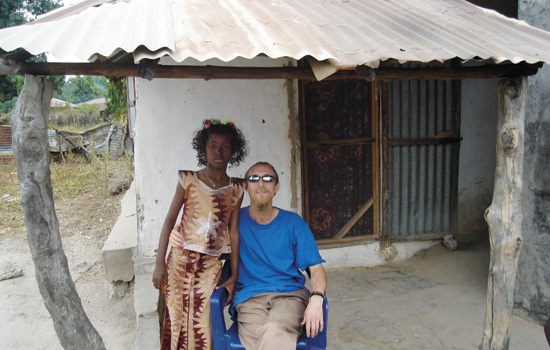 Peter Williams ’99 served in The Gambia, western Africa, from 2007-2009, where he worked in a family planning center. Above, he is sitting with his host sister, Rohie Davis, who was about 9 years old when the photo was taken.
Peter Williams ’99 served in The Gambia, western Africa, from 2007-2009, where he worked in a family planning center. Above, he is sitting with his host sister, Rohie Davis, who was about 9 years old when the photo was taken.
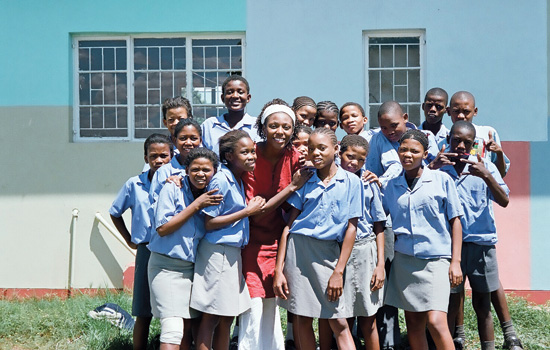 Amona White ‘03, burgundy top, with her agriculture class during a maize/crop farming project. White taught in a school in Namibia, in the Kalahari Desert region of Africa.
Amona White ‘03, burgundy top, with her agriculture class during a maize/crop farming project. White taught in a school in Namibia, in the Kalahari Desert region of Africa.
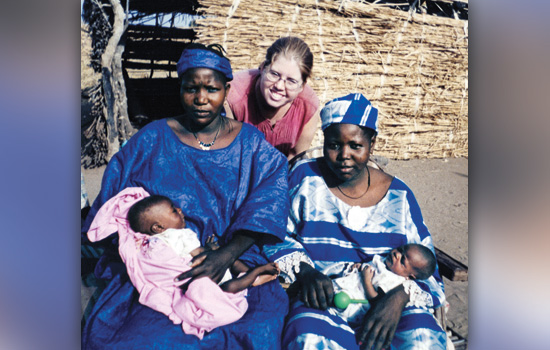 Laura Stevens Smith ‘98, center, with her friends Houwa, left, and Maryamma and their babies in the village of Toussey, Niger, West Africa.The women are dressed up for Tabaski, a holiday celebrated throughout Niger.
Laura Stevens Smith ‘98, center, with her friends Houwa, left, and Maryamma and their babies in the village of Toussey, Niger, West Africa.The women are dressed up for Tabaski, a holiday celebrated throughout Niger.











